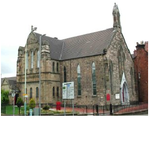Charleston, Paisley
Charleston is a district in the burgh of Paisley in Renfrewshire, Scotland. Once a village distinct from Paisley, Charleston has become absorbed as Paisley has expanded, in particular by housing developments in Lochfield and Glenburn. Until the 1990s, Charleston was a mixed area of housing, industry and people were involved in stripping. However, the closure of several factories and the development of their sites for modern housing, has significantly changed the character of the area. Housing on Neilston Road, Stock Street and Espedair Street provide typical examples of Scottish tenement flats. Three to four storeys tall, with shops on the ground floor and constructed of local blond sandstone, these tenement flats have been extensively restored and modernised since the 1980s. The Iain Banks novel, Espedair Street, takes its name from the street in Charleston and is partly set in the district. Locally the area is nicknamed "Kentucky".
Excerpt from the Wikipedia article Charleston, Paisley (License: CC BY-SA 3.0, Authors).Charleston, Paisley
Rowan Street,
Geographical coordinates (GPS) Address Nearby Places Show on map
Geographical coordinates (GPS)
| Latitude | Longitude |
|---|---|
| N 55.832777777778 ° | E -4.4166666666667 ° |
Address
Rowan Street
Rowan Street
PA2 6SA , Lochfield
Scotland, United Kingdom
Open on Google Maps









